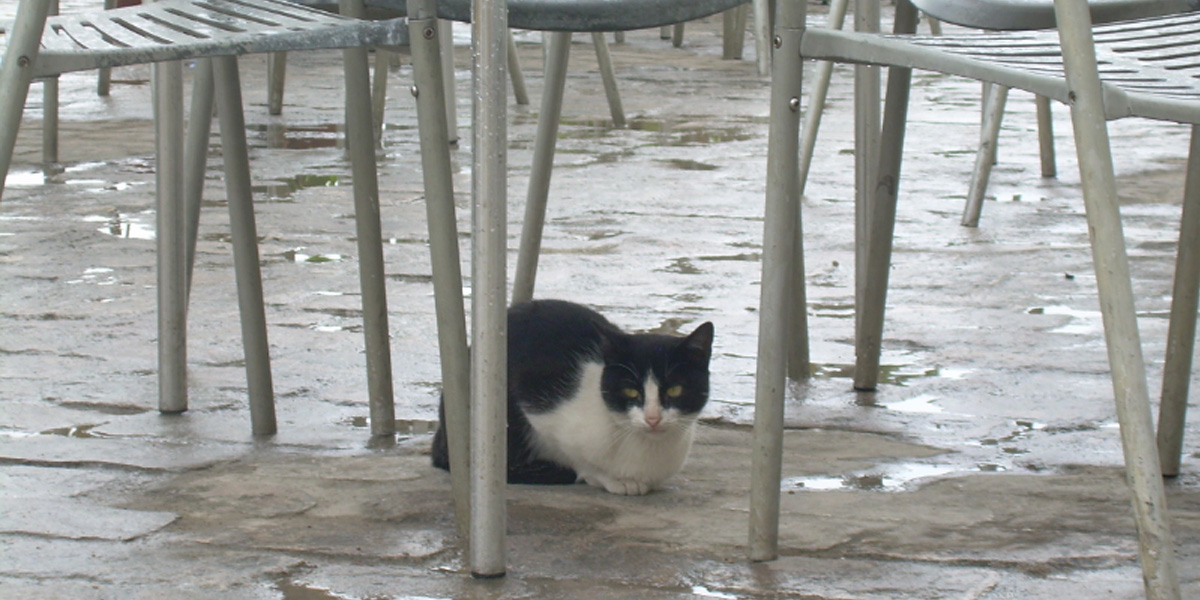Fear of Thunderstorms in Dogs and Cats
Doctor of Veterinary Medicine

While efforts are made to answer all questions as quickly as possible, if an immediate answer is required or if your pet is in need of urgent or emergency care, contact your pet's veterinarian immediately.
Doctor of Veterinary Medicine

You will receive an answer from Dr. Lindsay and our vet/tech team as soon as possible, usually the same day.
All answers are provided for informational or educational purposes only, and are intended to be a supplement to, and not a substitute for, the expertise and professional judgment of your pet's veterinarian.
It may be necessary to consult your pet's veterinarian regarding the applicability of any opinions or recommendations with respect to your pet's symptoms or medical condition.
CloseDoctor of Veterinary Medicine

An error has occurred, please reload the page and try again.
CloseWhile efforts are made to answer all questions as quickly as possible, if an immediate answer is required or if your pet is in need of urgent or emergency care, contact your pet's veterinarian immediately.
There is no answer related to your question

Thunderstorm phobia in pets
Although it is commonly termed as a "thunderstorm phobia," pets may develop a fear for thunder, lightning, and other weather conditions, such as rain, sleet, strong wind, changes in illumination (from lightning flashes), and even snow. Some dogs may begin to show behavioral signs of storm phobia well before a storm actually arrives, or even when there is a nearby storm of which the owner is unaware. These behavioral and nervous signs may include:
Behavioral signs:
- Hiding (most common sign in cats)
- Compulsive seeking of the owner's company
- Trembling or shaking
- Ignoring commands
- Vocalizing (barking, howling, meowing)
- Trying to escape - includes digging, running away, biting and scratching at doors
Nervous signs:
- Dilated pupils
- Excessive salivation (drooling)
- Trembling or shaking
- Pacing
- Panting
- Chewing
- Urinating
- Defecating
Treatment for fear of storms in dogs and cats
Over time, the behavior of storm phobic or scared pets may escalate and result in panic. It is during these times when dogs and cats may cause injury to themselves by trying to escape from the anxiety-provoking stimulus. Some dogs have broken screen and glass doors or windows in attempts to outrun the causes of their fear.
Because hiding is common among pets that are scared of storms, they usually choose places that are covered and dark, such as a closet or behind furniture. In some cases, dogs may also prefer to seek shelter in a bathroom. The theory behind this behavior is because the air in the bathroom is more calming (ionized). Frantic barking, destruction, and attempts to escape are also common in storm phobic dogs.
Offer your dog or cat a crate or kennel as a safe refuge instead of allowing them to hide in a closet or behind furniture. Crates and kennels are also a convenient place for your pet to sleep and can be used for training purposes.
Some dogs may be predisposed to storm phobias due to genetics or from inadequate socialization as puppies. However, it is important to know that even dogs that are well adjusted may also become affected. Signs of phobic dogs are initially apparent between one and five years of age, although many dogs may be less than 12 months old at the time the problem begins.
Obviously upsetting for your pet, storm phobias are a problem from an animal welfare perspective. Additionally, the behavior shown by your pet, especially dogs, is extremely upsetting for pet owners, who are distressed by their pet's anxiety and by the resulting damage inflicted on their homes. If a dog or cat's phobia of storms is not properly addressed, it can weaken the owner-pet bond and lead to pet abandonment, placement in a shelter or alternate home or even, in the severest cases, to euthanasia.
There are no pharmacologic treatments registered to treat storm phobias. Although some drugs have been tried off-label, including benzodiapines and acepromazine, the latter may sometimes make the signs worse. Anti-anxiety drugs such as selective serotonin reuptake inhibitors (Fluoxetine) and tricyclic antidepressants (Clomipramine) have also been used. The disadvantage of giving these types of drugs is that treatment must begin two or more weeks before the phobia-initiating stimulus. All drugs carry a risk of side effects, typically excessive sedation, and some may cause vomiting and other problems.
To avoid the effects some drugs may cause, many pet owners seek alternative therapies, such as homeopathic remedies or appeasing pheromones in the Adaptil Collar for Dogs or Sentry Calming Collar for Cats. These products contain a synthetic mixture of compounds that mimic natural stress-relieving pheromones for a continuous calming effect. Homeopathy involves giving very small doses of remedies that would produce the same or similar symptoms of illness in healthy pets if they were given in larger doses.
Thundershirt can help reduce your pet's fear and anxiety
Thundershirt is an affordable, drug-free solution for anxiety problems in your furry friend. It uses gentle, constant pressure on your pet's torso (like a constant hug) to help calm your nervous pet. It does not contain any pheromones or drugs, so it will help keep your pet calm but not lethargic during storms, fireworks, or times of stress (travel, car trips to the veterinarian).
Experts believe that the pressure of the Thundershirt has a calming effect on your pet's nervous system. Like acupuncture and acupressure does for people, applying pressure to dogs and cats has been proven to help calm them in stressful situations. In fact, 80% of dog owners who tried Thundershirt for a variety of anxiety problems noticed improvement in their dogs.
If your pet seems nervous or anxious when seeing the Thundershirt, try putting it on the floor and giving your pet some food, using the Thundershirt as a plate. This trick often works because many pets become more comfortable with anything they associate with food.
 Swipe
Swipe

































